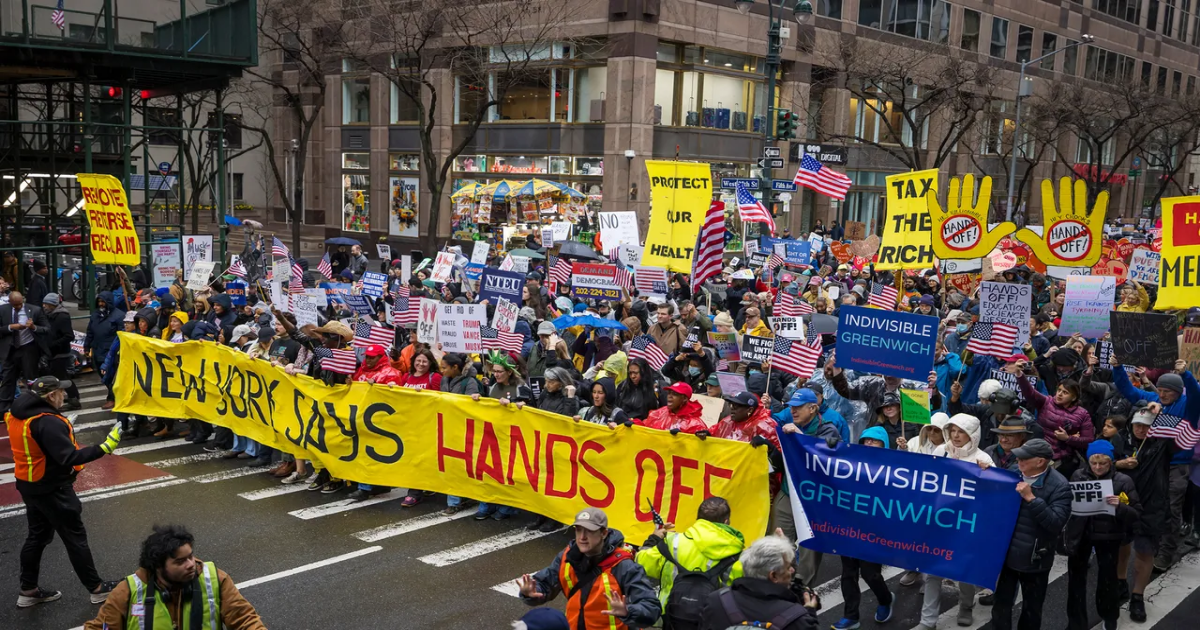It took 75 days of Donald Trump’s second presidency for voters to hit the streets en masse. Millions of people showed up this weekend for more than 1,200 anti-Trump demonstrations—all of them peaceful—throughout all 50 states, from Alaska to Alabama to Arizona. According to data journalist G. Elliott Morris, “general search interest for the term protest even surpassed levels during Trump’s first term, except for the summer 2020 protests on racial justice and policing.”
What makes this show of force especially notable is how the demonstrations spread through so many different local communities, including in some typically MAGA-friendly terrain. There was “a strong signal that this is not constrained to liberal cities,” Laura Gamboa, a political scientist and professor at Notre Dame, tells me. “Democrat and Republican constituents are unhappy.”
Of course, there are a lot of complicated reasons for the cynicism and despair that currently characterize American life. But what the protesters are unhappy about is quite simple: Trump and Elon Musk are on a crusade to gut broad swaths of the federal government, threatening vital components of the welfare state, including Social Security and Medicare. Recent polling has pointed to public frustrations with Trump and the DOGE-ification of American life, as I’ve previously noted, but this past weekend’s “Hands Off!” protests vividly revealed how Trumpism and its many forms of fuckery have truly broken through to the wider electorate, something members of the mainstream media—myself included—had been wondering about.
The demonstrations don’t just show that the president’s bad policies are penetrating the consciousness of the greater electorate; they also function as tangible evidence that Trumpism isn’t popular and that the larger electorate won’t just go along with it. “[The protests] prove that the Trumpist regime’s main justification for its authoritarian assertion of power—that Trump has a ‘mandate,’ that he’s enacting the ‘will of the people,’ that his agenda represents a broad consensus—is a dangerous lie that we must not perpetuate,” historian Thomas Zimmer, a visiting professor at Georgetown, tells me. “They remind others that such acts of public defiance are indeed possible; they encourage people who may have felt alone or defeated; they create community even across large geographical distances.”
Perhaps the most important thing achieved by the millions of people who took to the streets was the creation of a sense of urgency around the critical races to come. Every seat in the House of Representatives will be up for election in November 2026. And Trump—as long as he bucks his nature by respecting a certain democratic norm—is a lame-duck president. Surely Republicans would like to preserve control of all branches of government, and these protests create an important visual for why they shouldn’t. “Collective action events connect individuals to other people and activist groups,” says Gamboa. “If grassroots movements can build from that, it could translate into actions that the government—but perhaps more importantly, members of Congress—cannot ignore.”
Trump spends a lot of time musing about the idea that the American people have given him a “mandate” to enact his radical agenda. “He’s used the word in speeches, interviews, or social media at least 50 times since being elected,” reports an NPR political correspondent. The president uses this propagandistic refrain because Project 2025 is, again, wildly unpopular. However, he also uses it because he’s insecure in his political position, which could be undermined by a calamitous global economy and fragile alliances with mercurial billionaires. After all, he lost the election just over four years ago, as well as the popular vote in 2016. His political fate, too, could turn on a dime.
If you think back to the liberal resistance to Trump in 2017, the pussyhats of the Women’s March, for instance, might seem cringe. But by the looks of what happened in 2020, they—and other forms of pushback—had an impact. The current protests are part of “an urgent call to action directed at the political leaders” who have “failed to put up meaningful resistance,” says Zimmer. “Without large-scale mobilization of the people,” he adds, “whatever is left of American democracy stands little chance.”
Marching in the street may seem trite or a bit cliché. But what’s been successful in the past can also be so in the present. The time for nuance is over; broad collective action and resistance are the only things that will save us.
